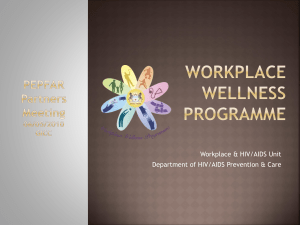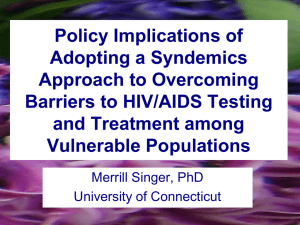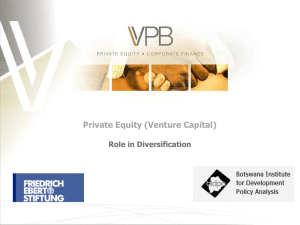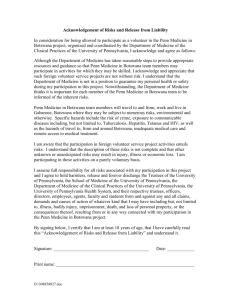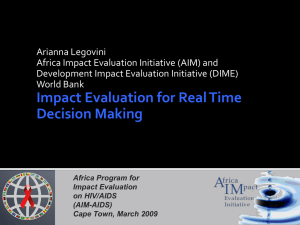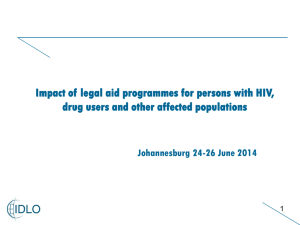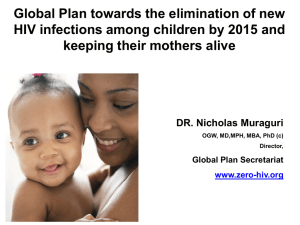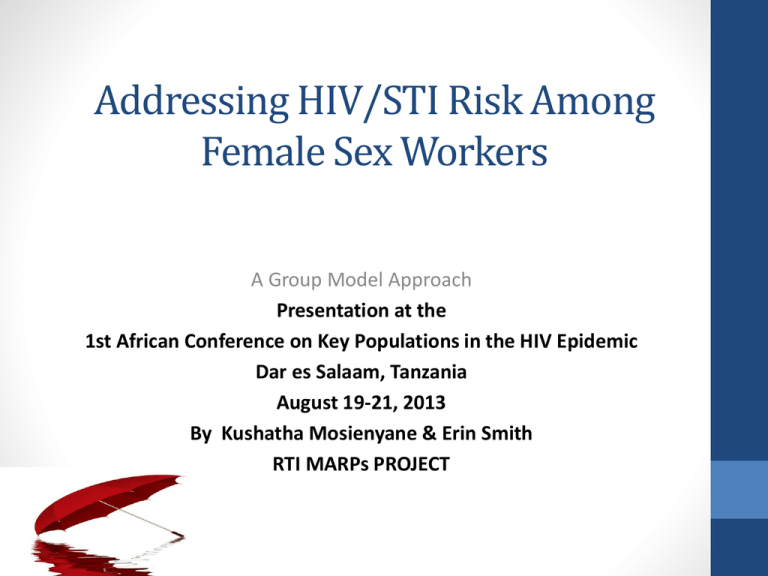
Addressing HIV/STI Risk Among
Female Sex Workers
A Group Model Approach
Presentation at the
1st African Conference on Key Populations in the HIV Epidemic
Dar es Salaam, Tanzania
August 19-21, 2013
By Kushatha Mosienyane & Erin Smith
RTI MARPs PROJECT
Agenda
•
•
•
•
•
•
•
Problem statement
Project information: Botswana HIV MARPs project
Background: risk reduction model
Project design
Lessons learned
Benefits of the group model
Conclusion
Problem Statement
The 2012 Biological Behavioral Surveillance
Survey of high risk sub-populations revealed
a 61.9% HIV prevalence rate among sex
workers (SW) in Botswana.
• In a program review, only 16% of program
respondents reported using condoms
“often” and 80% said they regularly had
unprotected sex with clients.
Problem Statement
• Program respondents reported clients
preference for dryness during intercourse.
To achieve this, drying agents are used
prior to work. Condoms are not used, or
often break.
• Of problems in the past year, customer
and partner violence ranked #1, with 82%
of participants reporting having
experienced incidents of gender based
violence (GBV).
Problem Statement
• High HIV prevalence, a preference for dry sex, and
high incidence of GBV all propel the continuation of
the HIV epidemic in Botswana, but sex workers face
multiple challenges to sustained risk reduction:
• Fractured, highly mobile populations with little or no sense
of community
• Exposed to physical and sexual abuse with little opportunity
for recourse due to the illegality of sex work in Botswana
• A large percentage have a history of severe psychological
shocks ( rape, physical and emotional abuse, abandonment,
political conflict, etc.)
• All program participants reported regular use of alcohol
during working hours
Project Information
• Botswana HIV-MARPs: a 5-year USAID project run by RTI
International.
• Targets: female sex workers ; male clients of sex workers;
men who have sex with men.
• Program Objectives:
• Develop and implement behavior change communication (BCC)
strategies that move beyond abstinence and fidelity to motivate
sustained behavior changes for risk reduction
•
•
• Bring services, such as voluntary HIV testing and counseling
(HTC), closer to the target populations through outreach
mechanisms
•
• Reduce barriers to access to care, and engage clients and
providers in defining and monitoring service quality
•
Background: Risk Reduction
Model
• Project staff identified a need to develop a different kind of
intervention to increase risk reduction activities among FSW in
Botswana.
• Based on multiple studies which show increasing solidarity
and a sense of community among FSW has been effective in
improving condom use, project staff reached out to the
University of Botswana’s Dr. Tirelo Modie-Moroka, an expert
in psycho-social and group counseling among sex workers.
• Together, this model was piloted, and rolled out to all project
areas.
Risk Reduction Model
Group Model Program Objective:
• Empower target populations to reduce their risk of
encountering violence and of becoming infected or infecting
others with HIV
• Build on multiple research reports showing that developing
group solidarity is one of the most effective risk reduction
techniques among sex workers
• Increase enrollment and adherence of ART
Project Design
• Technical officers of CSO’s working with key
populations were trained in:
•
•
•
•
•
•
•
Group counseling methods
HIV risk reduction
Substance abuse
Gender based violence
Poverty alleviation
Sex workers rights
Effective referrals for services
Project Design
• From 2011 to 2013, a total of 100 women aged 22 – 45 years
were enrolled for the group counseling model across three
districts
• Groups met twice a month, guided by facilitators with
mentorship from the HIV-MARPs project specialist
• Discussion was open forum, allowing women to talk about
whatever they wanted within the guidelines of the group
objectives
Lessons Learned
• In the group settings, women found a sense of community and
support that they had not previously received
• Women participating in the group model reported feeling
groups were a safe environment to discuss matters that
cannot be explored through more conventional models
• Groups offered a true peer experience where women were
free to discuss their common daily problems such as,
• Causal factors influencing engagement in sex work,
• Realities of gender based violence
• Challenges behind leaving sex work for alternate
employment
• Money struggles
• Relationship problems
Benefits of the Group Model
• The group setting allowed women to:
• Build relationships among themselves
• Create a safety net effect on the job which supported
decreased risk taking
• Improve self esteem
• Improve sense of community
• Improve access to care and treatment services
• Increase enrollment into ART and improve adherence
• Develop protection strategies to decrease gender based
violence
• Set common prices and insist on condom use during sex
(refusing to accept more money for condom free sex)
Conclusion
• The group psychosocial counseling model for SWs in Botswana
has yielded positive results:
• Offering a safe environment for sharing
experiences
• Allowing SWs to build a network of trust among
their peers
• Supporting positive choices towards risk
reduction
• Accessing health services
• Increasing adherence, and in some cases
• Exiting sex work


